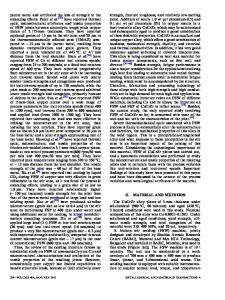Friction Stir Welding of Low-Carbon Shipbuilding Steel Plates: Microstructure, Mechanical Properties, and Corrosion Beha
- PDF / 4,476,981 Bytes
- 14 Pages / 593.972 x 792 pts Page_size
- 61 Downloads / 367 Views
DUCTION
SHIPS are built generally by joining steel sheets/plates and various profiles. The welding process allows for the construction of large vessels using fully welded joints as a result of improvements in welding technology.[1] At present, arc welding with covered electrodes and gas metal arc welding are mostly used in the shipbuilding industry. But the search for alternative welding methods has increased due to the need for high-quality welding, the necessity of cleaning the slag formed after welding, and the distortions on the workpiece after welding with regular techniques. Friction stir welding (FSW) seems to be one of the best alternatives considering its advantages over the traditional welding techniques. It is a solid-state welding method developed by the British Welding Institute in 1991, particularly for the welding of aluminum alloys, which are difficult to weld with high-heat-input welding D.M. SEKBAN is with the Department of Naval Architecture and Marine Engineering, Karadeniz Technical University, Trabzon, Turkey. Contact E-mail: [email protected] S.M. AKTARER is with the Department of Automotive Technology, Recep Tayyip Erdogan University, Rize, Turkey. G. PURCEK is with the Department of Mechanical Engineering, Karadeniz Technical University, Trabzon, Turkey. Manuscript submitted January 8, 2019. Article published online June 27, 2019 METALLURGICAL AND MATERIALS TRANSACTIONS A
methods.[2,3] During FSW, materials are exposed to lower heat input than the melt welding methods, and a relatively narrow heat affected zone (HAZ) occurs. Due to the low heat input during FSW, a large HAZ causing negative metallurgical changes does not form. Thus, the FSW method has shown a significant improvement especially in joining of hard-to-weld materials. FSW was first used for joining of aluminum alloys, also in various metallic materials like magnesium, copper, and steel as a result of development of tool materials and design.[4–8] In this method, a nonconsumable rotating tool with a specially designed pin and shoulder is inserted into the abutting edges of the sheets or plates to be joined and traversed along the line of the joint. More information about the application principles of this method can be found in the literature.[9–11] The joining of steels plates by FSW has become popular, and many studies have been published on the FSW of steels in different grades,[12–28] most of which have focused on parametric optimization of welding and their effect on structural and mechanical properties.[12,14–16,18,19,21,24–28] By examining these studies, it is observed that changing the parameters in the same direction will not have the same effect on the properties depending on the material used and the selected parameters. The microstructural changes of the steels during FSW were investigated in many studies, and it was discovered that the microstructure formed during FSW was related to many factors such as the VOLUME 50A, SEPTEMBER 2019—4127
microstructure of the base material, the temperature reached during FSW, and c
Data Loading...











